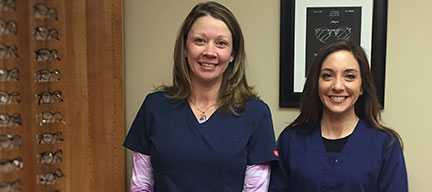_opt.jpg) Myopia (Nearsightedness): Nearsighted individuals typically have problems seeing well at a distance and are forced to wear glasses or contact lenses. The nearsighted eye is usually longer than a normal eye, and its cornea may also be steeper. Therefore, when light passes through the cornea and lens, it is focused in front of the retina. This will make distant images appear blurred. There are several refractive surgery solutions available to correct nearly all levels of nearsightedness.
Myopia (Nearsightedness): Nearsighted individuals typically have problems seeing well at a distance and are forced to wear glasses or contact lenses. The nearsighted eye is usually longer than a normal eye, and its cornea may also be steeper. Therefore, when light passes through the cornea and lens, it is focused in front of the retina. This will make distant images appear blurred. There are several refractive surgery solutions available to correct nearly all levels of nearsightedness.
Hyperopia (Farsightedness): Farsighted individuals typically develop problems reading up close before the age of 40. The farsighted eye is usually slightly shorter than a normal eye and may have a flatter cornea. Thus, the light of distant objects focuses behind the retina unless the natural lens can compensate fully. Near objects require even greater focusing power to be seen clearly and therefore, blur more easily. LASIK, Refractive Lens Exchange, and Contact lenses are a few of the options available to correct farsightedness.
Astigmatism: Asymmetric steepening of the cornea or natural lens causes light to be focused unevenly, which is the main optical problem in astigmatism. To individuals with uncorrected astigmatism, images may look blurry or shadowed. Astigmatism can accompany any form of refractive error and is very common.
Astigmatism can be corrected with glasses, contact lenses, corneal relaxing incisions, laser vision correction, and special implant lenses.
Presbyopia: Presbyopia is a condition that typically becomes noticeable for most people around age 45. In children and young adults, the lens inside the eye can easily focus on distant and near objects. With age, the lens loses its ability to focus adequately. Although presbyopia is not completely understood, it is thought that the lens and its supporting structures lose the ability to make the lens longer during close vision effort. To compensate, affected individuals usually find that holding reading material further away makes the image clearer. Ultimately, aids such as reading glasses are typically needed by the mid-forties. Besides glasses, presbyopia can be dealt with in a number of ways. Options include monovision and multifocal contact lenses, monovision laser vision correction, and new presbyopia correcting implant lenses.

Cataract: A cataract is a clouding of the natural lens in your eye that causes reduced quality of vision such as duller colors and difficulty in low light conditions. Cataracts affect nearly 22 million Americans age 40 and older. For many, it's simply part of the aging process. In fact, more than half of all Americans have cataracts by age 80. Traditionally this is covered by insurance when a standard lens is implanted. Premium lenses may require additional out of pocket funds.
Multi-focal lens implants: when a cataract is removed, a lens must replace your natural lens which is what has become a "cataract". Insurance provides a standard single vision lens option. Or there have been many advancements in technology which have provided patients with alternative "specialty" lenses which correct vision at multiple distances or high definition distance as well as astigmatism-reducing lenses. Dr. Bucci is the #1 multi-focal surgeon in PA - Top 10 in the USA. During your cataract consultation, he will discuss what lens options are available in order to deliver "your" best visual outcome.
The LENSAR Cataract Laser System: as part of your advanced cataract procedure, it is safe, effective and uses the same laser technology that has been used in LASIK procedures for over a decade. This procedure with its 3-d view of your eye provides more accurate information and treatment options during your cataract removal process by performing the initial stages of the procedure and breaking down your cataract using the laser versus manual techniques. This is an elective procedure and is not covered by insurance.

iLASIK is a procedure that corrects vision by reshaping the cornea using the most advanced technology. It is one of the most popular forms of vision correction due to its accuracy, safety, quick recovery time, a wide range of correction and minimal discomfort. The entire procedure takes only a short time, both eyes can be done the same day, and no stitches or patches are necessary. LASIK is a bladeless, customizable treatment performed in order to make patients glasses-free. This procedure can treat patients with nearsightedness, farsightedness, and astigmatism. This is an elective procedure and is not covered by insurance.
PRK: PRK is the original method of laser eye correction. This method Dr. Bucci may recommend for patients whose corneas may be too thin for iLASIK, or have a prescription that falls outside the range or iLASIK. This is still a customizable treatment that allows patients to be glasses-free. However, the surface of the cornea is treated directly (without a flap) therefore the healing process may take several days and often a medical clear contact is applied " like a band-aid" to assist in the corneal healing. This is an elective procedure and is not covered by insurance.
YAG: After cataract surgery, some patients experience cloudiness in their vision. This cloudiness is caused by a thickening of the membranes in the eye and can easily be treated by this laser, which breaks up the membranes in order to restore the clear vision. This is usually covered by insurance check with your insurance representative.
AK: Astigmatic keratotomy is a surgical procedure used to correct astigmatism by making incisions on the steepest part of the cornea. These incisions cause the cornea to relax and take a more rounded shape, thereby reducing astigmatism. Often recommended after cataract surgery. This may be covered by an insurance check with your insurance representative.